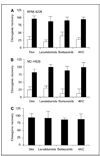Clonogenic multiple myeloma progenitors, stem cell properties, and drug resistance
- PMID: 18172311
- PMCID: PMC2603142
- DOI: 10.1158/0008-5472.CAN-07-3096
Clonogenic multiple myeloma progenitors, stem cell properties, and drug resistance
Abstract
Many agents are active in multiple myeloma, but the majority of patients relapse. This clinical pattern suggests most cancer cells are eliminated, but cells with the clonogenic potential to mediate tumor regrowth are relatively chemoresistant. Our previous data suggested that CD138(+) multiple myeloma plasma cells cannot undergo long-term proliferation but rather arise from clonogenic CD138(neg) B cells. We compared the relative sensitivity of these distinct cell types to clinical antimyeloma agents and found that dexamethasone, lenadilomide, bortezomib, and 4-hydroxycyclophosphamide inhibited CD138(+) multiple myeloma plasma cells but had little effect on CD138(neg) precursors in vitro. We further characterized clonogenic multiple myeloma cells and stained cell lines using the Hoechst side population and Aldefluor assays. Each assay identified CD138(neg) cells suggesting that they possess high drug efflux capacity and intracellular drug detoxification activity. We also found that multiple myeloma cells expressing the memory B-cell markers CD20 and CD27 could give rise to clonogenic multiple myeloma growth in vitro and engraft immunodeficient nonobese diabetes/severe combined immunodeficient mice during both primary and secondary transplantation. Furthermore, both the side population and Aldefluor assays were capable of identifying circulating clonotypic memory B-cell populations within the peripheral blood of multiple myeloma patients. Our results suggest that circulating clonotypic B-cell populations represent multiple myeloma stem cells, and the relative drug resistance of these cells is mediated by processes that protect normal stem cells from toxic injury.
Figures




References
-
- Oken MM, Harrington DP, Abramson N, Kyle RA, Knospe W, Glick JH. Comparison of melphalan and prednisone with vincristine, carmustine, melphalan, cyclophosphamide, and prednisone in the treatment of multiple myeloma: results of Eastern Cooperative Oncology Group Study E2479. Cancer. 1997;79:1561–1567. - PubMed
-
- Singhal S, Mehta J, Desikan R, et al. Antitumor activity of thalidomide in refractory multiple myeloma. N Engl J Med. 1999;341:1565–1571. - PubMed
-
- Richardson PG, Schlossman RL, Weller E, et al. Immunomodulatory drug CC-5013 overcomes drug resistance and is well tolerated in patients with relapsed multiple myeloma. Blood. 2002;100:3063–3067. - PubMed
-
- Richardson PG, Barlogie B, Berenson J, et al. A phase 2 study of bortezomib in relapsed, refractory myeloma. N Engl J Med. 2003;348:2609–2617. - PubMed
-
- Kyle RA, Rajkumar SV. Multiple Myeloma. N Engl J Med. 2004;351:1860–1873. - PubMed
Publication types
MeSH terms
Substances
Grants and funding
LinkOut - more resources
Full Text Sources
Other Literature Sources
Medical
Research Materials

